William Quiller Orchardson facts for kids
Quick facts for kids
William Quiller Orchardson
|
|
|---|---|

Portrait from Men of Mark, 1876–1883
|
|
| Born | 27 March 1832 Edinburgh, Scotland
|
| Died | 13 April 1910 (aged 78) London, England
|
| Nationality | British |
| Spouse(s) | Helen Moxon (m. 1873) |
Sir William Quiller Orchardson (born March 27, 1832 – died April 13, 1910) was a famous Scottish artist. He was known for painting portraits of people, scenes from everyday life, and historical moments. He was given the title of Knight in June 1907 when he was 75 years old.
Contents
Early Life and Art School
William Quiller Orchardson was born in Edinburgh, Scotland. His father was a businessman.
When he was fifteen, William went to a famous art school in Edinburgh called the Trustees' Academy. His teacher was Robert Scott Lauder. Many other talented Scottish artists of that time were also his classmates.
Even though he wasn't the most hardworking student, his art showed a special care and a strong desire to make his paintings look exactly as he saw them. This meant his early artworks were just as good as his later, more famous ones.
By the time he was twenty, William had learned all the important parts of art. He had even painted a portrait of a sculptor named John Hutchison. For the next seven years, he continued to work in Edinburgh. He also practiced a "black and white" style of drawing.
Moving to London
In 1862, when he was thirty, William Orchardson moved to London, England. He set up his art studio at 37 Fitzroy Square. A year later, his friend John Pettie joined him there. Another famous artist, Ford Madox Brown, later lived in the same house.
At first, people in England were not very interested in Orchardson's paintings. His art was often quiet and didn't grab attention easily at the Royal Academy art shows. His friend Pettie became more popular before him.
Orchardson focused on simple ideas and designs for his paintings. He used calm colors. Some of his best-known paintings from his first eighteen years in London include The Challenge, Christopher Sly, Queen of the Swords, Conditional Neutrality, and Hard Hit. He also painted portraits of his wife and her father. All these paintings showed his good judgment, creative ideas, and amazing painting skills.
Later Years and Achievements
The years between 1862 and 1880 were a time of quiet success for Orchardson. In 1868, he was chosen as an A.R.A. (Associate of the Royal Academy). This was an important step for an artist.
In 1870, he spent the summer in Venice, Italy. He traveled back home through France during a war. On April 6, 1873, he married Helen Moxon. In 1877, he became a full member of the Royal Academy. That same year, he finished building his house called Ivyside in Westgate-on-Sea. It had a tennis court and an art studio in the garden.
William Orchardson kept painting until the end of his life. He had three portraits ready for the Royal Academy show in 1910, the year he passed away. He died in London on April 13, 1910, just a few weeks after his 78th birthday. He had been knighted (given the title "Sir") less than three years before his death.
Famous Artworks
Orchardson became much more popular after 1880. That year, he showed a large painting called Napoleon on board the Bellerophon at the Royal Academy. This painting was bought for the national art collection.
For more than ten years, people eagerly looked forward to seeing Orchardson's new paintings at the Academy. After the Napoleon painting, he showed Voltaire in 1883. This painting is considered one of his best in terms of skill.
In 1884, he painted "Marriage de convenance," which became one of his most popular works. He followed this with "The Salon of Madame Récamier" in 1885, and "After" (a follow-up to "Marriage de convenance") in 1886. Other famous paintings include "The First Cloud" (1887), "Her Mother's Voice" (1888), and "The Young Duke" (1889).
Later, he painted many pictures that used the fancy Empire style of furniture and clothing. These paintings often showed old musical instruments, beautiful carpets, and dresses from that time. Titles like "An Enigma" and "Her First Dance" hinted at the stories in these artworks.
Orchardson also painted many important portraits. Some of his well-known portraits include "Mrs Joseph," "Mrs Ralli," and "Sir Walter Gilbey, Bart." He also painted a special group portrait of Queen Victoria with her son, grandson, and great-grandson for the Royal Agricultural Society.
Works


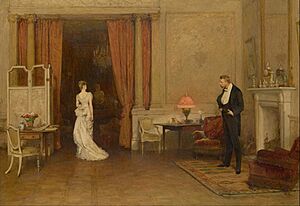

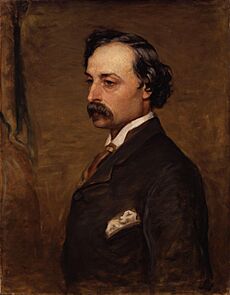
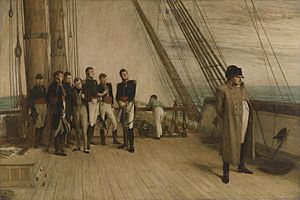
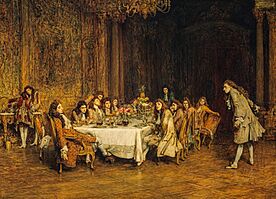
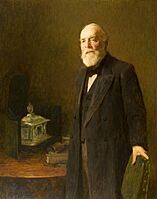



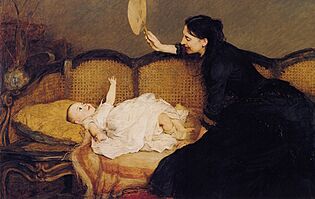
![Portrait of [[Peter Nicol Russell|Sir Peter Nicol Russell]]](/images/thumb/2/21/Peter_Russell%2C_Esq.tif/161px-Peter_Russell%2C_Esq.tif.jpg)